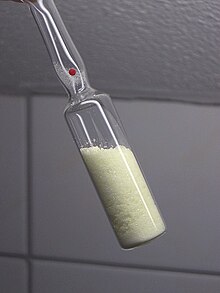
| |||
| |||

| |||
| Names | |||
|---|---|---|---|
| IUPAC names
Phosphorus pentachloride
Pentachloro-λ5-phosphane | |||
| Other names
Pentachlorophosphorane
| |||
| Identifiers | |||
3D model (JSmol)
|
|||
| ChemSpider | |||
| ECHA InfoCard | 100.030.043 | ||
| EC Number |
| ||
PubChem CID
|
|||
| RTECS number |
| ||
| UNII | |||
| UN number | 1806 | ||
CompTox Dashboard (EPA)
|
|||
| |||
| |||
| Properties | |||
| Cl5P | |||
| Molar mass | 208.22 g·mol−1 | ||
| Appearance | yellowish white crystals | ||
| Odor | pungent, unpleasant[1] | ||
| Density | 2.1 g/cm3 | ||
| Melting point | 160.5 °C (320.9 °F; 433.6 K) | ||
| Boiling point | 166.8 °C (332.2 °F; 439.9 K) sublimation | ||
| reacts | |||
| Solubility | soluble in CS2, chlorocarbons, benzene | ||
| Vapor pressure | 1.11 kPa (80 °C) 4.58 kPa (100 °C)[2] | ||
| Structure | |||
| tetragonal | |||
| D3h (trigonal bipyramidal) | |||
| 0 D | |||
| Thermochemistry | |||
Heat capacity (C)
|
111.5 J/mol·K[2] | ||
Std molar
entropy (S⦵298) |
364.2 J/mol·K[2] | ||
| Hazards | |||
| GHS labelling: | |||
   [3] [3]
| |||
| Danger | |||
| H302, H314, H330, H373[3] | |||
| P260, P280, P284, P305+P351+P338, P310[3] | |||
| NFPA 704 (fire diamond) | |||
| Flash point | Non-flammable | ||
| Lethal dose or concentration (LD, LC): | |||
LD50 (median dose)
|
660 mg/kg (rat, oral)[4] | ||
LC50 (median concentration)
|
205 mg/m3 (rat)[4] | ||
LCLo (lowest published)
|
1020 mg/m3 (mouse, 10 min)[4] | ||
| NIOSH (US health exposure limits): | |||
PEL (Permissible)
|
TWA 1 mg/m3[1] | ||
REL (Recommended)
|
TWA 1 mg/m3[1] | ||
IDLH (Immediate danger)
|
70 mg/m3[1] | ||
| Safety data sheet (SDS) | ICSC 0544 | ||
| Related compounds | |||
Related phosphorus pentahalides
|
Phosphorus pentafluoride Phosphorus pentabromide Phosphorus pentaiodide | ||
Related compounds
|
Phosphorus trichloride Phosphoryl chloride | ||
Except where otherwise noted, data are given for materials in their standard state (at 25 °C [77 °F], 100 kPa).
| |||
Phosphorus pentachloride is the chemical compound with the formula PCl5. It is one of the most important phosphorus chlorides/oxychlorides, others being PCl3 and POCl3. PCl5 finds use as a chlorinating reagent. It is a colourless, water-sensitive solid, although commercial samples can be yellowish and contaminated with hydrogen chloride.
- ^ a b c d NIOSH Pocket Guide to Chemical Hazards. "#0509". National Institute for Occupational Safety and Health (NIOSH).
- ^ a b c Phosphorus pentachloride in Linstrom, Peter J.; Mallard, William G. (eds.); NIST Chemistry WebBook, NIST Standard Reference Database Number 69, National Institute of Standards and Technology, Gaithersburg (MD) (retrieved 2014-05-15)
- ^ a b c Phosphorus pentachloride
- ^ a b c "Phosphorus pentachloride". Immediately Dangerous to Life or Health Concentrations (IDLH). National Institute for Occupational Safety and Health (NIOSH).


